7th Oct 2020, 8:15 – 9:22 AM
Slightly windy, little sunshine.
The first fifteen minutes spent in observation was more interesting than last time. I noticed the wonderful pear tree, which even though having no canopy, provided an excellent shade for me. Initially, I was startled but eventually figured out how this was possible. I considered that the sun’s angle of incidence was taken care of, by the tree’s tall structure. This was because the sun was behind the tree not above it as usual. The umbra shadow formed was my shelter. This whole scenario reminds me of eclipses.
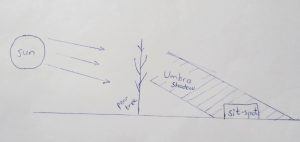
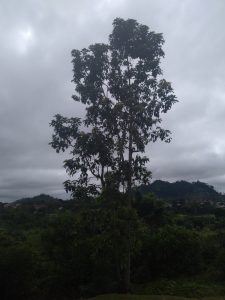
Surprisingly, the first sound I heard was the bleating of either a sheep, a goat or a ram. I still can’t tell the difference especially because I did not see the animal. The real description of the sound was; “meeh eeh eeh”. It came from the eastern part of the up-hill farm. A bee came flying around me but I wondered why I did not hear its buzzing sound. Was it that they didn’t always buzz? I doubted it was a bee. Perhaps it was another insect that looked like it. I also heard bird sounds from the squirrel’s tree. I would like to know when they are laughing, talking or singing as they make those sounds. They were less noisy this time.
The field was my most captivating part of this story. It all started with me looking out for the immature mushrooms I identified last time. I got to realize that they had withered and were uprooted.
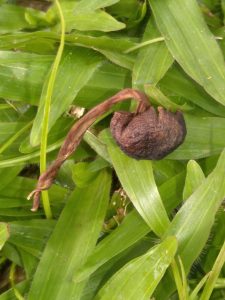
Just when I thought all of them were gone, I stumbled on one that had rather matured. It was whiter and looked greyish.
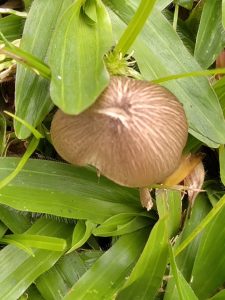
I saw spiders, ants and other special insects I did not know, on the field floor. I now had an idea of what and who were responsible for the sounds emanating from its grasses. The spiders were colorful and I had never seen them before. They seemed to be the species; Tarantulas theraphosidae. I was not very successful in taking nice pictures of them because they were too mobile.
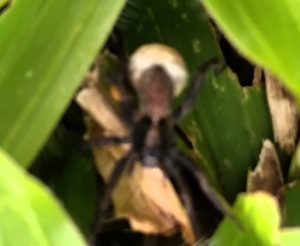
At last, the invertebrate I got to focus on, was a grasshopper (Omocestus viridus). It was static for a while. It started moving between the grasses and I followed it so as not to lose it. It stopped abruptly and began using one of its limbs to scratch its head. I found that funny but it made sense because grass is naturally itchy. I know this because I’ve had the opportunity to rub myself in it. The grasshopper was being caressed all along by the grass so obviously it felt the effect. I took note of the fact that it was camouflaging since it looked exactly like the grass upon which it laid. What a great way to escape from predators.
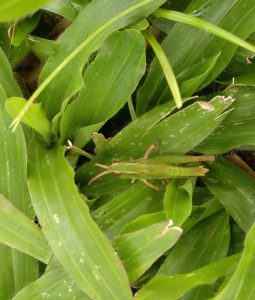
The valley region of my sit-spot used to have a visible water body which dried up. However, it gets swampy especially after heavy rains. This provides a perfect breeding ground for mosquitoes. That’s why I try to be well covered when going to my sit-spot so I don’t become a delicious meal for them. The rain enables earthworms to aerate the soil. If the soil is too dry, they would have difficulty creating holes between its particles. This action of worms with the help of water enhances soil fertility. With the cohesive and adhesive properties of water, plants can suck it up their xylem vessels depending on the field capacity. They use the water for their metabolic processes like photosynthesis. The rain lowered the environmental temperature as it evaporated. This low temperature seemed to make many organisms dormant. For example; no lizard nor squirrel was seen. Even the sounds coming from the field floor were fainter. This is unlike last time when it was sunny and hotter.
I can call this experience new and exciting. I witnessed many new things and I was glad I could have an explanation for some of them. Apart from the eclipse episode discussed in the first paragraph, I saw that the tender guava tree’s stem was bent. I came up with a conclusion that it was trying to put itself in the best position for maximum sunlight absorption. The mango tree above it was covering it so it was tilting towards the open sky away from the canopy. I got very fulfilled as I devised a strategy to know whether guava tree had shed its leaves. I looked at the ground around it and saw dried leaves that looked like the ones on it. They looked very different from those shed by the mango trees which were all around. Nature caught my attention and I was so distracted by it. Overall, I did more of observing than writing because I told myself I could do that later if I had seen enough. The seeing had to be momentary. That was why I did not think of taking a video of the spiders. I was busy admiring them.
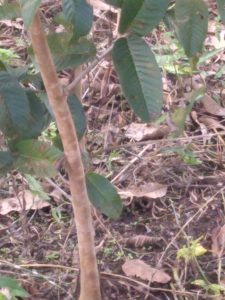

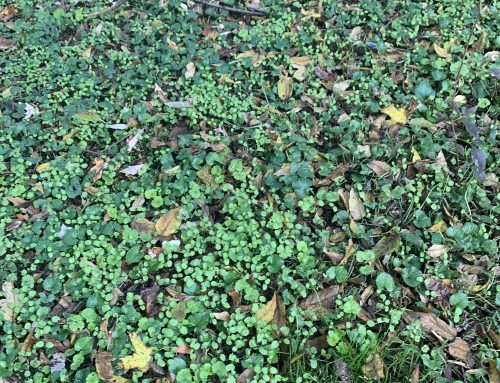
I love the way you described how the pear tree created a shaded area over your sit-spot, so you were able to observe comfortably. I also like the fact that you sketched out a picture of what you described. This is also my first time seeing a pear tree, so it is definitely a lovely tree and SUPER tall! I can’t wait to see one in person one day.
Yeah! I was glad I could observe comfortably. I just remembered that what we locally call “pear” is what you call “avocado”. 🙂
I really enjoyed your blog post Sheki – particularly your thoughts on water! Thank you for taking me with you on your sit-spot journeys!
Thanks, ma’am! :-):-):-)
I loved your post Sheki! You have so much in your sit spot to observe and enjoy. Squirrels are my favorite so I was happy to read there’s a whole family near your spot and that they seem happy and active.